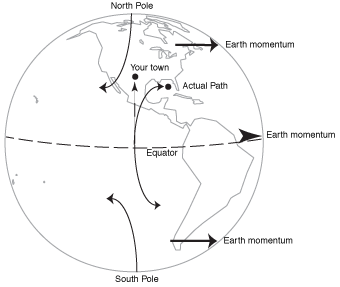Weather: What Makes the Weather Go 'Round
What Makes the Weather Go 'Round
While high and low pressure areas are defined by sinking and rising air, they are also characterized by spinning motions. In the Northern Hemisphere, high pressure areas spin clockwise and low pressure areas spin counterclockwise. Just the opposite spin is put on the atmosphere in the Southern Hemisphere. It's all because of a mysterious force called Coriolis force. I can't begin to tell you how often I've wanted to write about the Coriolis force, which makes the atmosphere go in circles. This is one of the most important elements of weather—and one of the most poorly explained. Throughout my learning years I badgered my teachers and seldom felt comfortable with their explanations of this magical mechanism. I've seen record players that turn the wrong way, carousels, and other assorted spinning devices used to explain why the atmosphere goes in circles. Usually, my head was spinning instead, clockwise and counterclockwise. Let's see if we can offer up a simpler explanation.
Weather-Speak
The Coriolis force is an apparent force due to the rotation of the earth. Moving objects, such as wind, are deflected to the right in the Northern Hemisphere and to the left in the Southern Hemisphere.
Weather-Wise
Bob Dylan claims you don't need a weatherman to know which way the wind blows: A north wind blows from the north. By the way, if you stand with your back to the wind and extend your right arm to the right of your body, it points toward high pressure. Your left arm, extended to the left side of your body, will point toward low pressure. In the Southern Hemisphere, it's the opposite. The weather can be as simple as knowing right from left.
The Coriolis force is named for Gaspard Coriolis, a nineteenth-century French scientist who figured out why weather systems spin. (For purists, he really didn't discover a force—more of an effect—so sometimes the spinning factor is called the Coriolis effect.) In any case, we begin with the knowledge that the earth is in motion. It is rotating on its axis. It goes around once a day. The atmosphere is attached to the earth because of gravity, so it goes around once a day, too, otherwise we would pass through the entire world's weather in just 24 hours. The following figure shows what's going on.
If you've got a globe handy, you might want to refer to it as you read this. Near the equator, where the earth is obviously widest, the outer edge of the earth's atmosphere is moving faster than it does around the poles. So the atmosphere gains a more west-to-east spin at the equator than, for example, at a latitude of 45 degrees north.

Coriolis force.
Let's say a system is moving north toward your town. It picks up a greater eastward momentum due to the extra force at the equator. So that system may have been heading straight toward you, but it arrives to the east, because of that eastward push. The eastward momentum, or motion, that system had near the equator is conserved, so the atmosphere is moving faster to the east than the earth is at that latitude. And this is what Coriolis force is all about.
In our example, the air arrives to the east (or the right) of its original heading. Now check out what happens in the Southern Hemisphere. The same principle applies, but because up is down in the Southern Hemisphere, the pocket shifts to the west of its original destination. You can try this out for motions in the opposite directions, too, and it works.

Circulation of highs and lows.
If you look in the direction that the air is moving, it will always shift to the right of its original path in the Northern Hemisphere and to the left in the Southern Hemisphere. This is a relative force, relative to the motion of the earth. If the earth weren't rotating and if it were a block, not a ball, there would be no Coriolis effect, and the weather would never go around in circles.
Now let's bring pressure into the mix (see the following figure). The air will naturally flow from pockets of high pressure to pockets of low pressure—just like what occurs when the air in a blown-up balloon (under high pressure) is released (into low pressure). The air is trying to go from high pressure to low, but Coriolis says, "Not so fast." The air gets spun to the right in the Northern Hemisphere and to the left in the Southern Hemisphere. North of the equator the air spins clockwise around the area of high pressure. Around the area of low pressure, the air turns counterclockwise.
In the atmosphere, there is nearly a balance between the Coriolis force, and the force generated by the air moving from high to low pressure areas. This balance is called geostrophic. It is a setup that is very simple but often very appropriate. In the early days of computer forecasting, motions were assumed to be geostrophic, and the predictions weren't bad.
Weather-Wise
The earth's rotation has been slowed by meteorological and tidal forces. A leap second was added Monday, June 30, 1997, to get the astronomical clock into sync with the standard atomic clock.
Weather-Speak
A balance between the pressure force and the Coriolis force is called geostrophic. The pressure force causes the air to move from high to low pressure. In the Northern Hemisphere the Coriolis force causes that motion to turn to the right. When that right directed motion is balanced by the pressure force, the flow is geostrophic.

Excerpted from The Complete Idiot's Guide to Weather © 2002 by Mel Goldstein, Ph.D.. All rights reserved including the right of reproduction in whole or in part in any form. Used by arrangement with Alpha Books, a member of Penguin Group (USA) Inc.
